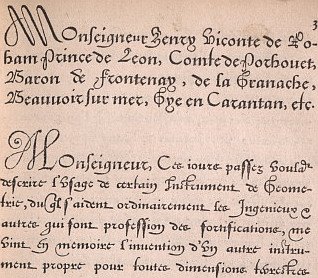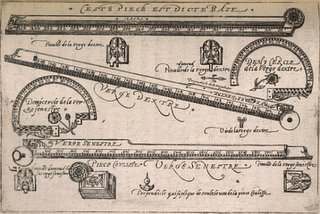





In addition to being in charge of the Paris Mint, Philippe Danfrie was also an inventor and engineer who built astrolabes and clocks and he cut his own type for his publications.
His invention seen here is a graphometer, essentially a simple theodolite with a graduated semi-circle and sight arms which could be affixed to a telescope if needed, but was mostly used for measuring horizontal and vertical angles by triangulation in surveying up until the mid-19th century.
[It was actually the beautiful lettering in the text that drew my attention and I am no typophile].
- Declaration de l'usage du Graphometre [1597] is online at the University of Virginia (thumbnail page).
- The Geometry of War at the Museum of the History of Science, Oxford University.
- Epact - Scientific Instruments of Medieval and Renaissance Europe.




















3 comments :
What an interesting little volume! It seems so petite for a technical work. Is it an octavo? The design of surveying instruments was popular among the proto-engineers of the sixteenth and seventeenth centuries. Jacques Besson--who was also a math tutor, pastor, and perfume maker--published a work called Le Cosmolabe which is devoted to his own surveying instrument. Henninger-Voss refers to this fascination as part of the "architectonic understanding of design."
The connection between technicians and mints is also interesting. Isaac de Caus is connected to the British Mint. He was named as the inheritor of the proceeds of Blondeau's milling machine. Much later, Nartov toiled at creating machinery for the Moscow mint.
I'm not sure of the size - it does seem like an 8vo.
The mint link I can't quite fathom, perhaps it's somewhat coincidental. Preindustrial metalwork would otherwise have included the smiths and ironwork trades I suppose - maybe the edumacated aficionados were drawn to the comparative gentility of 'shopwork' over foundry-type employment? --- I'm just riffing here.
Oh, in passing I found another interesting image of our graphometer by Manesson-Mallet in 1702.
I will have to show this to the uni teacher who taught me reference work - apparently all good librarians 'triangulate' their sources if they are not sure about something.
Post a Comment
Comments are all moderated so don't waste your time spamming: they will never show up.
If you include ANY links that aren't pertinent to the blog post or discussion they will be deleted and a rash will break out in your underwear.
Also: please play the ball and not the person.
Note: only a member of this blog may post a comment.